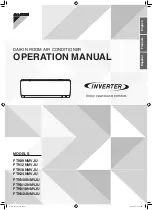
Push-Pull Liquid Recovery
The Push
-
Pull Liquid Recovery
mode is used for
transferring large volumes of liquid refrigerant.
The
RecoverXLT
®
“pulls” vapor from the
recovery cylinder and produces high pressure
discharge gas that “pushes” liquid out of the
HVAC system and into the recovery cylinder. The
auto purge feature makes the reconfiguration to
vapor recovery easier and faster to do.
Some HVAC systems will not allow for the push
-
pull recovery method. If any of the following
conditions apply, do not use push
-
pull method, but
follow the instructions
page 4 for
RecoverXLT
®
.
System contains less than 10 pounds of
refrigerant.
System is a heat pump or other unit with a
reversing valve.
System has an accumulator between the
service ports used in liquid recovery.
The refrigerant system does not allow for the
formation of a solid column of liquid.
For push
-
pull recovery, a sight glass is monitored
during recovery. When liquid is no longer visible,
stop recovery and finish recovering using the
VAPOR recovery process for
RecoverXLT
®
as
described on page 4.
When push
-
pull recovery is complete, a small
amount of refrigerant remains in the system. For
complete recovery, the system must be pulled into
a vacuum as required by EPA standards. This
process requires the following equipment:
1)
An extra hose for the push
-
pull recovery.
2)
A recovery cylinder with about 5 lbs. of
refrigerant.
3)
A sight glass
(Note: Make sure sight glass is
rated for the pressure of the refrigerant
being recovered)
.
Follow these steps:
1)
Turn off power to the system to be serviced.
2)
Hook up the
RecoverXLT
®
, the system to be
recovered, and the recovery tank as shown in
the diagram above.
3)
Purge all hoses
of non
-
condensables before
recovering refrigerant into recovery cylinder.
4)
Open valves on the recovery tank.
5)
Turn the selector valve to VAPOR position.
6)
Start the
RecoverXLT
®
using the momentary
switch.
7)
Monitor the sight glass. When the passing
liquid is no longer visible through the sight
glass, the push
-
pull method of recovery is
complete.
8)
Close the VAPOR valve on the recovery tank
and let the recovery continue.
9)
Turn the selector valve clockwise to the
PURGE position and follow procedures for
purging the
RecoverXLT
®
.
10)
Close LIQUID valve on recovery tank.
11)
Reconnect the hoses per the procedure for the
RecoverXLT
®
vapor recovery instructions.
12)
Rotate the selector valve to the VAPOR
position.
13)
Continue recovery until the unit
stops
or
reaches the appropriate level of vacuum.
Note: See page 4 for a detailed
set of
instructions on Vapor Recovery.
5
Push-Pull Recovery Diagram




























